GIÚP EM BÀI NÀY VỚI Ạ,EM CẦN GẤPP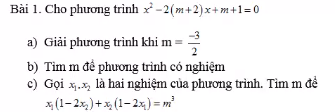
Hãy nhập câu hỏi của bạn vào đây, nếu là tài khoản VIP, bạn sẽ được ưu tiên trả lời.


Tọa độ giao điểm A,B là nghiệm của hệ phương trình:
\(\left\{{}\begin{matrix}x^2=2x+3\\y=2x+3\end{matrix}\right.\Leftrightarrow\left\{{}\begin{matrix}\left(x-3\right)\left(x+1\right)=0\\y=2x+3\end{matrix}\right.\Leftrightarrow\left(x,y\right)\in\left\{\left(3;9\right);\left(-1;1\right)\right\}\)
vậy: A(3;9); B(-1;1)



b: Tọa độ của F là:
\(\left\{{}\begin{matrix}x+2=-\dfrac{1}{2}x+2\\y=x+2\end{matrix}\right.\Leftrightarrow F\left(0;2\right)\)

a: Xét ΔABD có
\(BD^2=AD^2+AB^2\)
nên ΔABD vuông tại A

\(a,m=1\Leftrightarrow\left\{{}\begin{matrix}x-y=1\\\dfrac{x}{2}-\dfrac{y}{3}=334\end{matrix}\right.\Leftrightarrow\left\{{}\begin{matrix}x=1+y\\\dfrac{1+y}{2}-\dfrac{y}{3}=334\end{matrix}\right.\\ \Leftrightarrow\left\{{}\begin{matrix}x=1+y\\3y+3-2y=2004\end{matrix}\right.\Leftrightarrow\left\{{}\begin{matrix}x=1+y\\y=2001\end{matrix}\right.\Leftrightarrow\left\{{}\begin{matrix}x=2002\\y=2001\end{matrix}\right.\)
\(b,\left\{{}\begin{matrix}mx-y=1\\\dfrac{x}{2}-\dfrac{y}{3}=334\end{matrix}\right.\Leftrightarrow\left\{{}\begin{matrix}mx-y=1\\3x-2y=2004\end{matrix}\right.\\ \Leftrightarrow\left\{{}\begin{matrix}mx-y=1\\y=\dfrac{3x-2004}{2}\end{matrix}\right.\Leftrightarrow\left\{{}\begin{matrix}mx-\dfrac{3x-2004}{2}=1\\y=\dfrac{3x-2004}{2}\end{matrix}\right.\\ \Leftrightarrow\left\{{}\begin{matrix}2mx-3x=-2002\\y=\dfrac{3x-2004}{2}\end{matrix}\right.\Leftrightarrow\left\{{}\begin{matrix}x\left(2m-3\right)=-2002\\y=\dfrac{3x-2004}{2}\end{matrix}\right.\)
Để hpt vô nghiệm thì \(x\left(2m-3\right)=-2002\) vô nghiệm
\(\Leftrightarrow2m-3=0\Leftrightarrow m=\dfrac{3}{2}\)

Bài 1:
a: Xét tứ giác OBAC có
\(\widehat{OBA}+\widehat{OCA}=180^0\)
Do đó: OBAC là tứ giác nội tiếp
hay \(\widehat{BOC}=135^0\)

Bài 2:
Tọa độ giao điểm là:
\(\left\{{}\begin{matrix}2x+y=3\\3x-2y=1\end{matrix}\right.\Leftrightarrow\left\{{}\begin{matrix}4x+2y=6\\3x-2y=1\end{matrix}\right.\Leftrightarrow\left\{{}\begin{matrix}x=1\\y=1\end{matrix}\right.\)
Thay x=1 và y=1 vào (d), ta được:
\(2m-1+1=5m\)
hay m=0





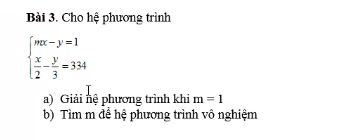
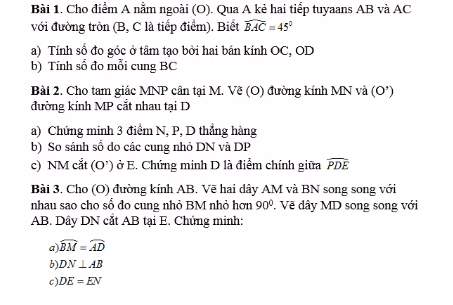
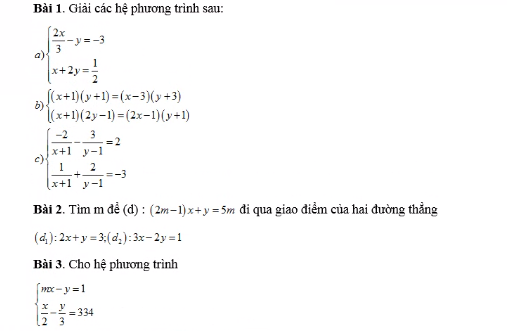
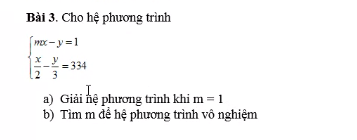
\(a,m=-\dfrac{3}{2}\Leftrightarrow x^2-2\cdot\dfrac{1}{2}\cdot x-\dfrac{3}{2}+1=0\\ \Leftrightarrow x^2-x-\dfrac{1}{2}=0\\ \Leftrightarrow2x^2-2x-1=0\\ \Delta'=1+2=3\Leftrightarrow\left[{}\begin{matrix}x=\dfrac{1+\sqrt{3}}{2}\\x=\dfrac{1-\sqrt{3}}{2}\end{matrix}\right.\\ b,\text{PT có }n_o\Leftrightarrow\Delta'=\left(m+2\right)^2-\left(m+1\right)\ge0\\ \Leftrightarrow m^2+3m+3\ge0\\ \Leftrightarrow\left(m+\dfrac{3}{2}\right)^2+\dfrac{3}{4}\ge0\left(\text{luôn đúng}\right)\)
Vậy PT có nghiệm với mọi m
\(c,\text{Viét: }\left\{{}\begin{matrix}x_1+x_2=2\left(m+2\right)\\x_1x_2=m+1\end{matrix}\right.\\ x_1\left(1-2x_2\right)+x_2\left(1-2x_1\right)=m^3\\ \Leftrightarrow\left(x_1+x_2\right)-4x_1x_2=m^3\\ \Leftrightarrow2\left(m+2\right)-4\left(m+1\right)=m^3\\ \Leftrightarrow m^3+2m=0\\ \Leftrightarrow m\left(m^2+2\right)=0\Leftrightarrow m=0\)